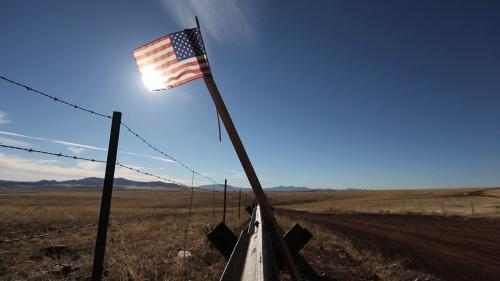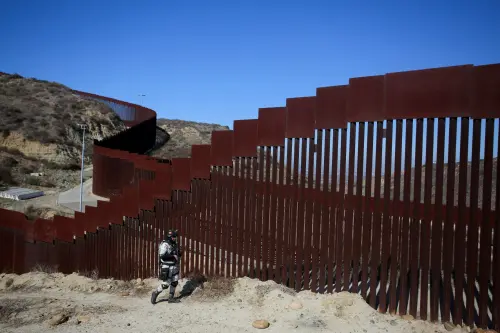The following post is adapted from the recent Brookings Essay “The Wall: The real costs of a barrier between the United States and Mexico,” by Vanda Felbab-Brown.
President Trump’s proposed border wall with Mexico would be costly and counterproductive in a number of ways, as I explained in more detail in my recent Brookings Essay. No matter how tall, deep, or thick a wall will be, illicit flows will cross, with undocumented workers and drugs finding their way into the United States regardless. Nor will the physical wall enhance U.S. security.
Here are 3 things that the proposed border wall will not accomplish, in spite of what the president and his supporters claim.
1 The wall won’t stop smuggling. Drug smugglers have been using tunnels to get drugs into the United States ever since Mexico’s most famous drug trafficker, Joaquín “El Chapo” Guzmán of the Sinaloa Cartel, pioneered the method in 1989. And the sophistication of these tunnels has only grown over time. In April 2016, U.S. law enforcement officials discovered a drug tunnel that ran more than half a mile from Tijuana to San Diego and was equipped with ventilation vents, rails, and electricity. It is the longest such tunnel to be found so far, but one of 13 of great length and technological expertise discovered since 2006. Altogether, between 1990 and 2016, 224 tunnels have been unearthed at the U.S.–Mexico border.
Other smuggling methods increasingly include the use of drones and catapults as well as joint drainage systems between border towns that have wide tunnels or tubes through which people can crawl and drugs can be pulled. But even if the land border were to become much more secure, that would only intensify the trend toward smuggling goods as well as people via boats that sail far to the north, where they land on the California coast.
Most importantly, as is already the case, both contraband and migrants will be hidden among legal cargo that passes the 52 ports of entry between the United States and Mexico. Checking every car, truck, and train compartment that crosses the border is simply not feasible because of time and costs. It would paralyze legal trade and the legal movement of people across the border.
2 The wall won’t significantly reduce homicides and other violent crime in the United States. The vast majority of violent crimes, including murders, are committed by native-born Americans. Multiple criminological studies show that foreign–born individuals commit much lower levels of crime than do the native-born. In California, for example, where there is a large immigrant population, including of undocumented migrants, U.S.-born men were incarcerated at a rate 2.5 times higher than foreign–born men.
Unfortunately, the Trump administration is promoting a counterproductive policing approach that insists on prioritizing hunting down undocumented workers, including by using regular police forces. There is powerful and consistent evidence that if people begin to question the fairness, equity, and legitimacy of law enforcement and government institutions, then they stop reporting crime, and homicides and other crimes increase.
Thus, efforts to recruit local police forces into immigration enforcement and Trump administration moves against sanctuary cities are highly disliked by many local police forces. For example in Texas, which has an estimated 1.5 million illegal immigrants, police chiefs of many major cities opposed a law by the Republican Governor Greg Abbott to impose draconian punishments against local police officials (such as removal from office, fines, and up to one-year imprisonment) who do not embrace immigration enforcement. In an op-ed in Dallas Morning News, they wrote: “The legislation is bad for Texas and will make our communities more dangerous for all.” They argued that immigration enforcement is a federal, not a state function, and that the new law would widen a gap between police and immigrant communities, discouraging cooperation with police on serious crimes and resulting in a wide underreporting of crimes perpetrating against immigrants. Police chiefs in other parts of the country, from Los Angeles to Denver, have expressed similar concerns and their dismay at having to devote their meager resources to hunting down undocumented workers.
3 The wall won’t help the U.S. economy or necessarily provide more long-term jobs to native-born Americans. There is little evidence that immigrants “steal” U.S. jobs and suppress wages of U.S. workers. According to a comprehensive National Academies of Sciences, Engineering, and Medicine analysis, immigration does not significantly impact the overall employment levels of most native–born workers. The impact of immigrant labor on the wages of native–born workers is also low. Immigrant labor does have some negative effects on the employment and wages of native–born high school dropouts, however, and also on prior immigrants, because all three groups compete for low–skilled jobs and the newest immigrants are often willing to work for less than their competition. The way to help those whose economic prospects are negatively affected by new immigrant arrivals is to provide them with vocational training and further education opportunities so they can become more competitive in the labor force with native-born Americans.
To a large extent, however, undocumented workers often work the unpleasant, back–breaking jobs that native–born workers are not willing to do. The fish–cutting industry, for example, is unable to recruit a sufficient number of legal workers and therefore is overwhelmingly dependent on an undocumented workforce.
Crucially, over the long run, immigration has positive effects on U.S. economic growth. The portion of foreign-born has risen from about 11 percent to 16 percent over the last 20 years, with immigrants and their children accounting for the vast majority of current and future workforce growth in the United States, at about 1 percent annually, a historically low level. If immigration to the United States were reduced so that foreign-born represent less about 10 percent of the overall population (compared with the current 14 percent), the number of working-age Americans in the coming decades would remain essentially the current 175 million, while the number of the elderly whom the working-age need to support will grow substantially, with fewer workers threatening the sustainability and benefits of Social Security and Medicare. While currently, 48 million draw Social Security, in 2050 that number is estimated to be 86 million. If immigration remains at the current 14 percent, then working-age Americans will increase by about 30 million in the next 50 years. Moreover, cities of all sizes are trying to recruit immigrants to offset population declines (which as discussed above are associated with the rise in crime, as well as crippling economic contraction), and to replenish the workforce. To keep enlarging the U.S. workforce is all the more important since U.S. productivity growth has slowed down sharply.
The Brookings Institution is committed to quality, independence, and impact.
We are supported by a diverse array of funders. In line with our values and policies, each Brookings publication represents the sole views of its author(s).








Commentary
3 things Trump’s proposed border wall with Mexico wouldn’t accomplish
September 26, 2017